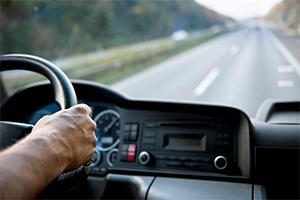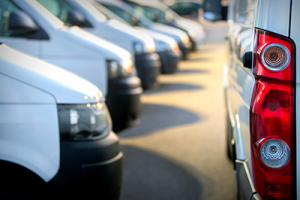Look before you back
Perhaps the most preventable and inexcusable accident is caused by backing into a parked auto or a fixed object. You should never commit this type of error as a professional driver.
Check around before you enter your vehicle
Investigate all around the outside of your vehicle for possible hazards which cannot be seen from the driver’s seat. This includes improperly parked vehicles next to yours, children and toys in driveways, and low objects such as hydrants, posts, abutments and fences. This investigative precaution is a good investment of only a second or two of your time.
In the driver’s seat
Keep your foot on the brake as you shift into reverse. Then, before starting to back, check traffic on both sides as well as the rear. Make sure nothing is hidden (blind spots). Don’t rely on your mirrors! Turn and look over your shoulder as well. Get help to guide you if you can’t avoid blind spots.
Know when and where to back
Driving in reverse normally should cover the shortest span possible — from inches to feet, not half a block. It should be a means of reaching a spot that will enable you to move forward quickly into the flow of traffic.
Never back down a street looking for a missed address. And, never back uphill or across lanes of traffic. It’s always wiser to drive around the block than to risk a conflict with oncoming traffic.
Be sure you're seen
When backing, move slowly — sound your horn before proceeding if there is any doubt that other traffic can see you.
Avoid backing
You can’t always avoid backing, but if you can it may prevent an accident.
This material is provided for informational purposes only and does not provide any coverage or guarantee loss prevention. The examples in this material are provided as hypothetical and for illustration purposes only. The Hanover Insurance Company and its affiliates and subsidiaries (“The Hanover”) specifically disclaim any warranty or representation that acceptance of any recommendations contained herein will make any premises, or operation safe or in compliance with any law or regulation. By providing this information to you. The Hanover does not assume (and specifically disclaims) any duty, undertaking or responsibility to you. The decision to accept or implement any recommendation(s) or advice contained in this material must be made by you.
LC 14-42
171-0860 (02/14)
Related resources
Look before you back
Perhaps the most preventable and inexcusable accident is caused by backing into a parked auto or a fixed object. You should never commit this type of error as a professional driver.
Check around before you enter your vehicle
Investigate all around the outside of your vehicle for possible hazards which cannot be seen from the driver’s seat. This includes improperly parked vehicles next to yours, children and toys in driveways, and low objects such as hydrants, posts, abutments and fences. This investigative precaution is a good investment of only a second or two of your time.
In the driver’s seat
Keep your foot on the brake as you shift into reverse. Then, before starting to back, check traffic on both sides as well as the rear. Make sure nothing is hidden (blind spots). Don’t rely on your mirrors! Turn and look over your shoulder as well. Get help to guide you if you can’t avoid blind spots.
Know when and where to back
Driving in reverse normally should cover the shortest span possible — from inches to feet, not half a block. It should be a means of reaching a spot that will enable you to move forward quickly into the flow of traffic.
Never back down a street looking for a missed address. And, never back uphill or across lanes of traffic. It’s always wiser to drive around the block than to risk a conflict with oncoming traffic.
Be sure you're seen
When backing, move slowly — sound your horn before proceeding if there is any doubt that other traffic can see you.
Avoid backing
You can’t always avoid backing, but if you can it may prevent an accident.
This material is provided for informational purposes only and does not provide any coverage or guarantee loss prevention. The examples in this material are provided as hypothetical and for illustration purposes only. The Hanover Insurance Company and its affiliates and subsidiaries (“The Hanover”) specifically disclaim any warranty or representation that acceptance of any recommendations contained herein will make any premises, or operation safe or in compliance with any law or regulation. By providing this information to you. The Hanover does not assume (and specifically disclaims) any duty, undertaking or responsibility to you. The decision to accept or implement any recommendation(s) or advice contained in this material must be made by you.
LC 14-42
171-0860 (02/14)
Related resources
Look before you back
Perhaps the most preventable and inexcusable accident is caused by backing into a parked auto or a fixed object. You should never commit this type of error as a professional driver.
Check around before you enter your vehicle
Investigate all around the outside of your vehicle for possible hazards which cannot be seen from the driver’s seat. This includes improperly parked vehicles next to yours, children and toys in driveways, and low objects such as hydrants, posts, abutments and fences. This investigative precaution is a good investment of only a second or two of your time.
In the driver’s seat
Keep your foot on the brake as you shift into reverse. Then, before starting to back, check traffic on both sides as well as the rear. Make sure nothing is hidden (blind spots). Don’t rely on your mirrors! Turn and look over your shoulder as well. Get help to guide you if you can’t avoid blind spots.
Know when and where to back
Driving in reverse normally should cover the shortest span possible — from inches to feet, not half a block. It should be a means of reaching a spot that will enable you to move forward quickly into the flow of traffic.
Never back down a street looking for a missed address. And, never back uphill or across lanes of traffic. It’s always wiser to drive around the block than to risk a conflict with oncoming traffic.
Be sure you're seen
When backing, move slowly — sound your horn before proceeding if there is any doubt that other traffic can see you.
Avoid backing
You can’t always avoid backing, but if you can it may prevent an accident.
This material is provided for informational purposes only and does not provide any coverage or guarantee loss prevention. The examples in this material are provided as hypothetical and for illustration purposes only. The Hanover Insurance Company and its affiliates and subsidiaries (“The Hanover”) specifically disclaim any warranty or representation that acceptance of any recommendations contained herein will make any premises, or operation safe or in compliance with any law or regulation. By providing this information to you. The Hanover does not assume (and specifically disclaims) any duty, undertaking or responsibility to you. The decision to accept or implement any recommendation(s) or advice contained in this material must be made by you.
LC 14-42
171-0860 (02/14)
Related resources
Look before you back
Perhaps the most preventable and inexcusable accident is caused by backing into a parked auto or a fixed object. You should never commit this type of error as a professional driver.
Check around before you enter your vehicle
Investigate all around the outside of your vehicle for possible hazards which cannot be seen from the driver’s seat. This includes improperly parked vehicles next to yours, children and toys in driveways, and low objects such as hydrants, posts, abutments and fences. This investigative precaution is a good investment of only a second or two of your time.
In the driver’s seat
Keep your foot on the brake as you shift into reverse. Then, before starting to back, check traffic on both sides as well as the rear. Make sure nothing is hidden (blind spots). Don’t rely on your mirrors! Turn and look over your shoulder as well. Get help to guide you if you can’t avoid blind spots.
Know when and where to back
Driving in reverse normally should cover the shortest span possible — from inches to feet, not half a block. It should be a means of reaching a spot that will enable you to move forward quickly into the flow of traffic.
Never back down a street looking for a missed address. And, never back uphill or across lanes of traffic. It’s always wiser to drive around the block than to risk a conflict with oncoming traffic.
Be sure you're seen
When backing, move slowly — sound your horn before proceeding if there is any doubt that other traffic can see you.
Avoid backing
You can’t always avoid backing, but if you can it may prevent an accident.
This material is provided for informational purposes only and does not provide any coverage or guarantee loss prevention. The examples in this material are provided as hypothetical and for illustration purposes only. The Hanover Insurance Company and its affiliates and subsidiaries (“The Hanover”) specifically disclaim any warranty or representation that acceptance of any recommendations contained herein will make any premises, or operation safe or in compliance with any law or regulation. By providing this information to you. The Hanover does not assume (and specifically disclaims) any duty, undertaking or responsibility to you. The decision to accept or implement any recommendation(s) or advice contained in this material must be made by you.
LC 14-42
171-0860 (02/14)





